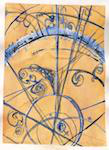Speaker
Description
In this work we study the underlying event (UE) activity as a function of the highest jet transverse momentum ($p_{\rm T}^{\rm jet}$) in terms of the number and summed $p_{\rm T}$ densities of charged particles in the azimuthal region transverse to the $p_{\rm T}^{\rm jet}$ direction. The UE activity considering charged particles within different $p_{\rm T}$ intervals in $pp$ collisions at $\sqrt{s}=7$ TeV is explored. Albeit MPI saturate for $p_{\rm T}^{\rm jet}>10$ GeV/$c$, UE still increases with increasing $p_{\rm T}^{\rm jet}$. We show that the saturations of both number and summed $p_{\rm T}$ densities are only observed for low-$p_{\rm T}$ charged particles ($0.5 < p_{\rm T} < 2$ GeV/$c$). Moreover, for the $p_{\rm T}$-integrated case ($p_{\rm T}>0.5$ GeV/$c$) the summed $p_{\rm T}$ density is not sensitive to the variation of color reconnection (CR). However, at low-$p_{\rm T}$ it is reduced with increasing CR, whereas an opposite behaviour is found at intermediate-$p_{\rm T}$ ($2 < p_{\rm T} < 10$ GeV/$c$). We also show that CR produces flow-like behaviour only in the UE region and the effects are reduced with increasing $p_{\rm T}^{\rm jet}$ due to the hardering of UE.
Finally we study the UE activity associated to identified leading particles. We found that for $2 < p_{\rm T} < 10$ GeV/$c$ the UE is sensitive to the leading particle species. We will discuss the origin of this effect in terms of minimum multiplicity associated to produce a given particle species and color reconnection. The outcomes encourage the measurement of inclusive and identified charged particle $p_{\rm T}$ spectra (over a wide range of $p_{\rm T}$) associated to UE aimed at better understanding the similarities between $pp$ and heavy-ion data discovered at the LHC.
